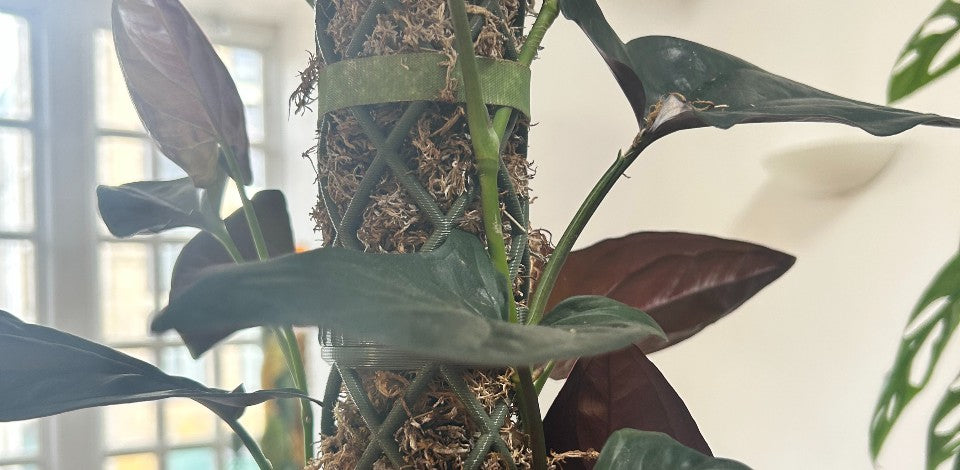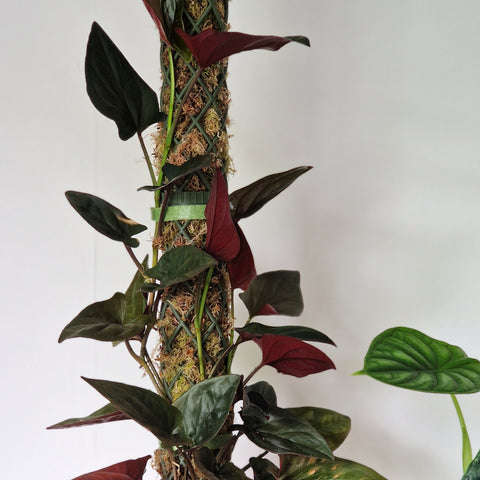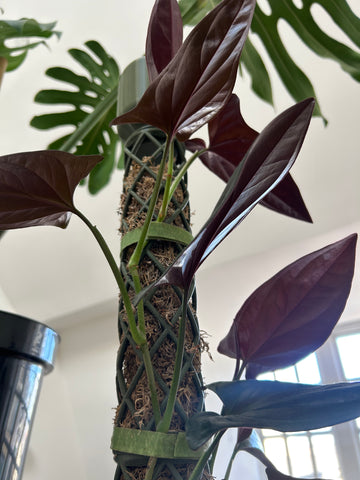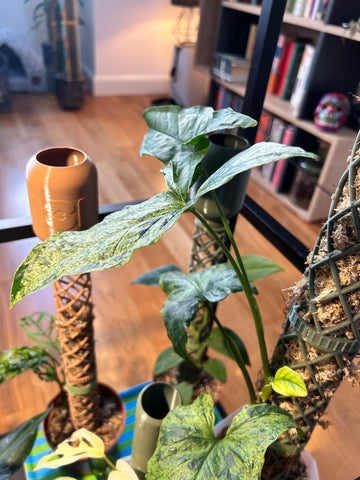
Syngonium success: why they love moss poles
Share
Syngoniums, sometimes known as arrowhead plants, are beautiful plants that deserve more air-time in the plant community.
They have great variegations and leaf patterns, plus there are many different types, so they are really fun to collect. They also have unique colours, some even in pastel shades (see Milk Confetti or Pink Splash).
And most Syngonium plants are also a great match for a moss pole; using moss poles will help enhance the growth and appearance of your Syngonium!
Here is our guide to Syngoniums and moss poles, and how you can make the most of these beautiful houseplants.

Syngoniums in a nutshell
Syngoniums are tropical plants native to Central and South America. They are part of the Araceae family and are prized for their arrowhead-shaped leaves that come in a variety of colours and patterns.
- Syngoniums are relatively low-maintenance and can thrive in a variety of indoor conditions.
- There are mini Syngoniums and larger ones, so they work for a variety of plant parent needs and spaces!
- Syngoniums are versatile plants that can be grown as trailing plants in hanging baskets, climbers on moss poles, or even as compact bushy plants in pots.
- Syngonium adaptability to different growing conditions makes them a popular choice for both beginner and experienced plant enthusiasts.

With their unique foliage and easy care requirements, Syngoniums are a great addition to any indoor plant collection! We definitely need to up our own Syngonium game, as we love the ones that we have... These plants are so easy to fall in love with.
What are some of the different types of Syngoniums?

There are several varieties of Syngoniums, each offering a different leaf shape, colour, and pattern. Some common types include:
- Syngonium podophyllum (aka Arrowhead vine): This is the most common type of Syngonium, known for its arrowhead-shaped leaves and varying shades of green. This is the "base format" of Syngoniums and there are lots of remixes!
- Syngonium Mottled/Mojito: A popular Arrowhead variation, the Syngonium Mottled is also known as Mojito, and it is one of the most popular Syngonium types out there right now. It has a lovely vibrant, mottled green colour.

- Syngonium Pink Splash: Another popular Arrowhead variant, this one has beautiful pastel pink leaves.
- Syngonium Albo variegata: Of course the Syngonium Albo is also gorgeous!
- Syngonium Milk Confetti: Also known as Syngonium podophyllum Milk Confetti, this is a very attractive and popular variegated Syngonium with delicate pastel leaves. It is a rarer form, but one that a lot of plant enthusiasts are raving about.
- Syngonium erythrophyllum/Syngonium Red Arrow: This variety features deep red or burgundy leaves, adding a pop of colour to any indoor space. The leaves are a bit smaller, and they are very glossy. (Pictured above, we love our Red Arrow).
- Syngonium macrophyllum: With its large, heart-shaped leaves, this type of syngonium is a striking addition to any plant collection.
And that is not even nearly all the Syngoniums... Batik, Panda, Three Kings; Syngoniums may have the best names?!

Moss poles + Syngoniums = perfect match?
The moss pole mimics the natural environment of climbing plants, stimulating root growth and allowing the plant to absorb nutrients more efficiently. Additionally, moss poles can help prevent the plant from becoming leggy or unruly.
Moss poles are a great way to provide support for climbing or vining plants like Syngoniums. To use a moss pole with your Syngonium, gently guide the plant's stems towards the pole and use soft plant ties or velcro gardening tape to secure them in place. Once in contact with the moist moss, your plant will start to reach out with its own little grippers, and quickly attach itself to the moss pole. You can then remove the tape (for aesthetic reasons mostly). As the plant grows, continue to train the stems to climb the pole for a beautiful and natural look.
Training a Syngonium to attach to a moss pole has not been hard in our experience; they are natural moss pole plants. (More moss pole tips here).
Using moss poles with Syngoniums not only provides support for the plant but also encourages healthy growth, encouraging the creation of a larger and more mature root system. The Syngoniums we have on moss poles have put out healthy, glossy leaves, and have grown in height and bushiness.

Why Syngoniums are such great plants
Syngoniums are not only visually appealing but also offer several benefits that make them ideal for indoor environments:
- Air purification: Syngoniums are known for their ability to purify the air by removing toxins and improving air quality.
- Low maintenance: These plants are easy to care for, requiring minimal watering and indirect sunlight, making them perfect for busy individuals.
- Adaptability: Syngoniums can thrive in a variety of indoor conditions, making them versatile plants for any home or office space.
- Some of the best colours and variants out there: Mojito, Pink Splash, Milk Confetti: you can't really beat these beautiful and unique leaf shades.
Whether you're a seasoned plant parent or just starting your indoor garden, Syngoniums are a great choice. With their diverse range of types and easy care requirements, these plants are sure to brighten up any room and provide numerous benefits for both you and your home. We love that more people are finding Syngoniums!



